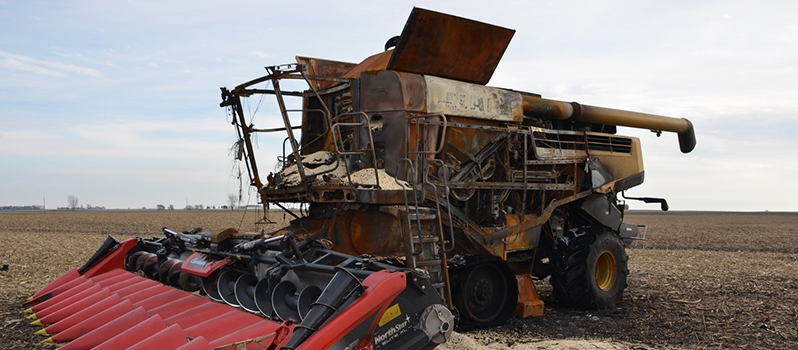
Loss Prevention Tips for the Harvest Season
By Sabine Voigt, Loss Control Consultant and Steve Carroll, Property Loss Consultant
Did you know that combine and tractor fires cause over $20 million in property losses each year in the U.S.? That is a substantial sum, especially since an estimated 75% of these fires are preventable.
Sometimes, the fire is caught early enough that it can be extinguished with a fully loaded and charged fire extinguisher and the implement can be repaired.
Many fires occur behind the cab of machines, which makes them difficult to discover during early stages. Fires are often noticed too late and the operator’s only option is to move to a safe distance and watch helplessly as their machinery becomes engulfed in flames.
That brings us to a loss scenario that WRC Property Loss Consultant Steve Carroll was involved in as a claims manager a few years ago.
This particular fire occurred on a windy fall day. As the insured was finishing work in a corn field, she smelled something burning and saw smoke filling the cab of her combine. The insured was able to shut down the combine and fortunately escaped without injury. She called 911 and was able to extinguish the main fire before the fire department arrived, but the combine ended up being a total loss.
As with most fires of unknown cause and in line with best practices, Steve assigned an origin and cause fire investigator for a thorough investigation. The investigator was able to determine the fire was caused by a build-up of field debris around a bearing. Ultimately, this loss could have easily been prevented with a five-minute stop and cleanout. Hundreds of farm equipment fires are reported each year, with combine fires accounting for 41% of the occurrences.
In addition to the loss of the implement itself, overall severity may range substantially depending on the location of the implement at the time of loss. If equipment is not cooled off and is parked inside a machine shed or building, you could face a potential loss involving not only the implement but the building and other equipment. A hot combine may have smoldering hot spots that could flare up and ignite.
Beyond the building itself, consider whether there is an adequate distance between the storage building and other buildings to minimize the risk of fire spread. Inspections of risks that include a bird’s eye view diagram displaying the overall layout with distances noted can be helpful.
While a large portion of farm implement fires are a result of field debris, fires also may be caused by mechanical/product issues. When these fires occur, it is possible that you as the insurer may have a potential subrogation recovery to address with the manufacturer, implement dealer or repair shop.
Recommendations
We recommend that when implement fires occur, you handle it just as you would a house fire by contacting origin and cause fire investigators, mechanical engineers and other professionals as these thorough investigations could lead to a subrogation recovery.
Maintenance and safety measures that can be taken to prevent loss are:
- Electrical systems should be checked for frayed wiring and worn connectors.
- The exhaust system should be kept in good repair.
- Fittings should be kept greased.
- The ground chain should be securely attached to the combine.
- A fully charged 10-pound ABC dry chemical extinguisher with Underwriting Laboratories (UL) approval should be in the combine cab and a second, larger extinguisher should be mounted on the outside of the machine at a height easily reached from ground level.
- A hot combine should be refueled only after a 15-minute cooldown period.
- Before harvest and for each different crop harvested, parts should be cleaned out. This includes the header, feederhouse, grain tank, straw walkers, ledges and frame rails, elevators and cross augers, sieves and chaffers, cylinder and/or rotor, shoe supply augers, unloading auger and rock trap.
If you would like to discuss loss prevention measures or these specific claims situations, please contact us at any time.
